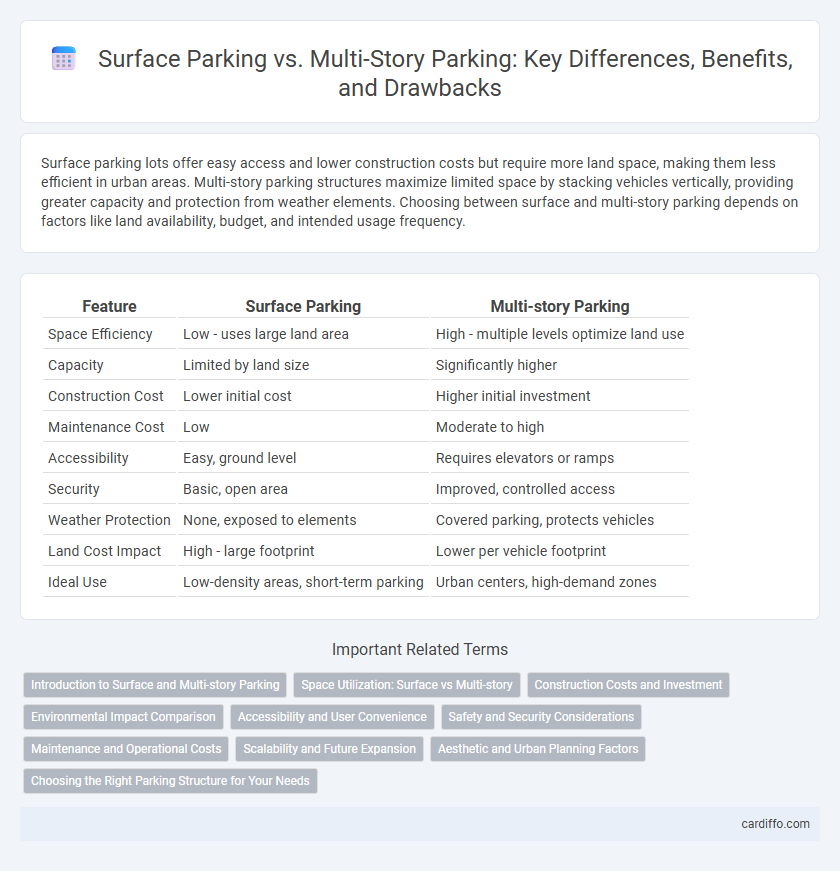Surface parking lots offer easy access and lower construction costs but require more land space, making them less efficient in urban areas. Multi-story parking structures maximize limited space by stacking vehicles vertically, providing greater capacity and protection from weather elements. Choosing between surface and multi-story parking depends on factors like land availability, budget, and intended usage frequency.
Table of Comparison
| Feature | Surface Parking | Multi-story Parking |
|---|---|---|
| Space Efficiency | Low - uses large land area | High - multiple levels optimize land use |
| Capacity | Limited by land size | Significantly higher |
| Construction Cost | Lower initial cost | Higher initial investment |
| Maintenance Cost | Low | Moderate to high |
| Accessibility | Easy, ground level | Requires elevators or ramps |
| Security | Basic, open area | Improved, controlled access |
| Weather Protection | None, exposed to elements | Covered parking, protects vehicles |
| Land Cost Impact | High - large footprint | Lower per vehicle footprint |
| Ideal Use | Low-density areas, short-term parking | Urban centers, high-demand zones |
Introduction to Surface and Multi-story Parking
Surface parking lots offer a cost-effective and flexible solution for vehicle storage by utilizing open land areas, often requiring less initial investment compared to multi-story structures. Multi-story parking garages maximize space efficiency in urban environments by providing vertical parking spaces, accommodating more vehicles per square foot while addressing limited land availability. Both parking types serve distinct urban planning needs, balancing accessibility, capacity, and construction costs.
Space Utilization: Surface vs Multi-story
Surface parking lots require significantly more land area per vehicle, typically around 300 square feet, resulting in inefficient space utilization in urban settings. Multi-story parking garages stack vehicles vertically, reducing the footprint by up to 70%, making them ideal for high-density areas. This vertical design maximizes space efficiency, allowing more cars to be accommodated within a limited land area.
Construction Costs and Investment
Surface parking requires significantly lower construction costs due to simpler design and minimal structural requirements, making it a cost-effective option for short-term investment. Multi-story parking involves higher initial capital expenditure driven by complex engineering, materials, and vertical construction, but maximizes land use efficiency and long-term revenue potential. Investment decisions must balance upfront expenses against spatial constraints and projected demand for parking capacity.
Environmental Impact Comparison
Surface parking lots contribute to urban heat islands by increasing impervious surfaces that absorb and radiate heat, leading to higher local temperatures and reduced groundwater recharge. Multi-story parking structures, although requiring more energy for construction and lighting, reduce land consumption and help preserve green spaces, mitigating habitat loss and stormwater runoff. Choosing multi-story parking supports sustainable urban development by balancing space efficiency with lower ecological disruption compared to expansive surface lots.
Accessibility and User Convenience
Surface parking offers easy access with minimal walking distance, making it ideal for quick stops and individuals with mobility challenges. Multi-story parking maximizes space efficiency in urban areas but may require elevators or stairs, potentially hindering user convenience for some drivers. Both types must balance accessibility features like ramps and clear signage to enhance overall user experience.
Safety and Security Considerations
Surface parking lots generally offer better visibility and natural surveillance, reducing the risk of theft and vandalism, while multi-story parking structures may present safety challenges due to limited lighting and multiple blind spots. Multi-story parking often requires enhanced security measures such as CCTV cameras, secure access controls, and improved lighting to mitigate risks associated with confined spaces. Both parking types benefit from regular patrols and emergency call stations to ensure occupant safety and quick response to incidents.
Maintenance and Operational Costs
Surface parking lots generally incur lower maintenance and operational costs due to simpler infrastructure, requiring less frequent repairs and minimal structural inspections. Multi-story parking garages involve higher expenses for structural upkeep, lighting, ventilation, and safety systems, contributing to increased maintenance budgets. Efficient cost management in multi-story facilities depends on regular inspections, timely repairs, and energy-efficient technologies to mitigate operational expenditures.
Scalability and Future Expansion
Surface parking offers limited scalability due to its expansive land use and inflexible layout, making future expansion costly and space-intensive. Multi-story parking structures maximize vertical space utilization, enabling higher vehicle capacity within a smaller footprint and allowing easier adaptation for increased demand. Investing in multi-story parking supports sustainable urban growth by accommodating scalability and future expansion more efficiently than surface lots.
Aesthetic and Urban Planning Factors
Surface parking lots often disrupt urban aesthetics by occupying expansive ground-level space that could otherwise support green areas or pedestrian infrastructure, leading to fragmented cityscapes and reduced walkability. Multi-story parking structures maximize land use efficiency, minimize urban sprawl, and can be designed with architectural elements that enhance the visual harmony of the area, contributing positively to urban planning goals. Incorporating mixed-use developments within multi-story parking facilities further supports vibrant street life and sustainable urban design.
Choosing the Right Parking Structure for Your Needs
Surface parking lots offer cost-effective construction and easy access but require more land, making them ideal for locations with ample space and lower urban density. Multi-story parking structures maximize space efficiency by accommodating more vehicles within a smaller footprint and are suitable for high-demand areas with limited land availability. Assess traffic volume, land cost, and user convenience to determine the optimal parking solution for residential, commercial, or urban settings.
Surface Parking vs Multi-story Parking Infographic

 cardiffo.com
cardiffo.com